The Qin Han Museum of Shaanxi History Museum
The Qin Han Museum of the Shaanxi History Museum is located in Qinhan New City, only half an hour's drive from Xi'an Xianyang International Airport. It is the only museum in China that focuses on the origin, development and contribution of civilization during the Qin and Han Dynasties (221 BC-220 AD). Currently, more than 1,500 relics are on display, with 90% of them being displayed for the first time. In addition, valuable relics such as the Gold Monster and the Tiger-Shaped Tally from the Shaanxi History Museum are also on display for visitors.
The museum consists of seven theme buildings, arranged in the layout of the Big Dipper, and each building is relatively independent and connected by corridors. Among them, buildings No. 1 to No. 5 are exhibition halls.
Must-See Cultural Relics in the Qin Han Museum of the Shaanxi History Museum
1. “Silk Road No. 1” Wooden Vessel
Han Dynasty (206 BC-220 AD)
The treasure of the museum, the earliest wooden boat discovered in China
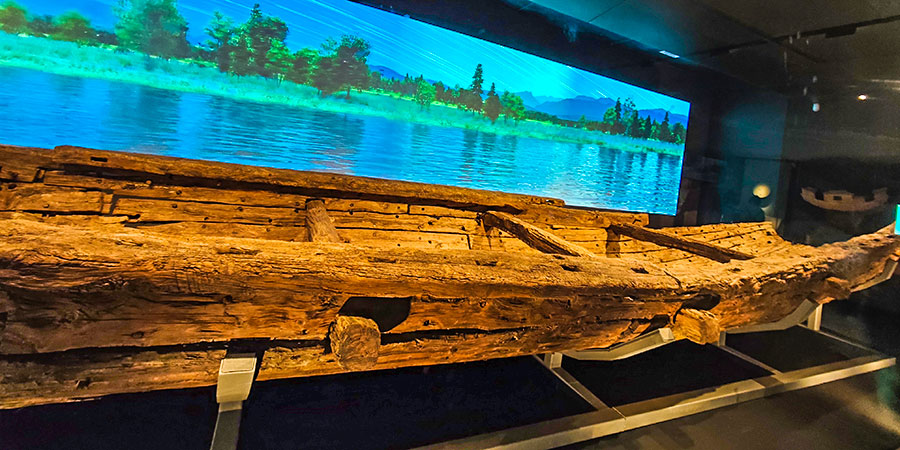 |
| The “Silk Road No. 1” Wooden Vessel in Qin Han Museum |
2. Tiger-Shaped Tally of Du
Han Dynasty (206 BC-220 AD)
A tiger-shaped commander's seal, a national treasure
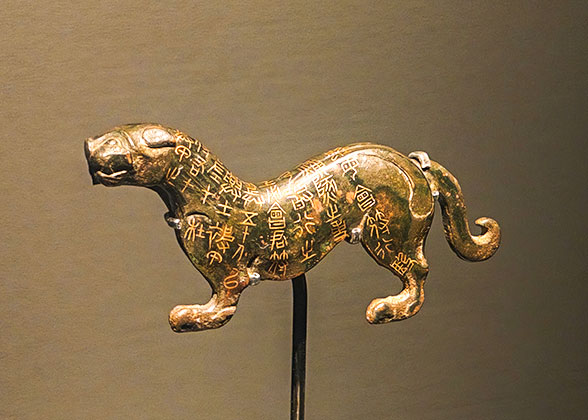 | 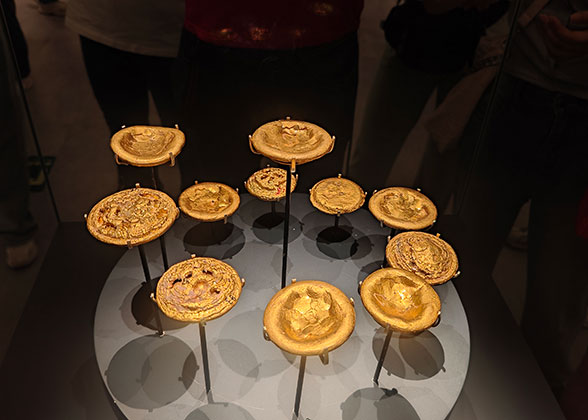 |
| The Tiger-Shaped Tally of Du in Qin Han Museum | Golden Discs in Qin Han Museum |
3. Golden Discs
Han Dynasty (206 BC-220 AD)
A group of gold currency
4. Gold Monster
Warring States Period (476 BC-221 BC)
A gold decoration in the shape of a mythical beast
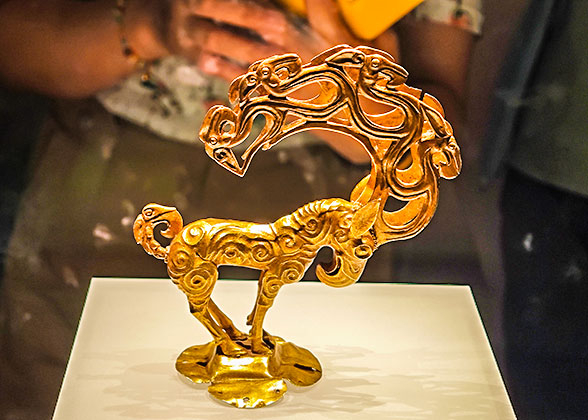 | 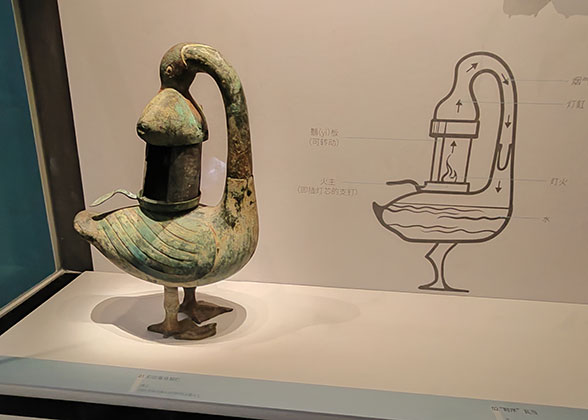 |
| The Gold Monster in Qin Han Museum | The Wild Goose and Fish Bronze Lamp in Qin Han Museum |
5. Wild Goose and Fish Bronze Lamp
Western Han Dynasty (202 BC-8 AD)
An environmentally friendly lamp
6. Giltbronze Silkworm
Western Han Dynasty (202 BC-8 AD)
A gilded silkworm, a national treasure
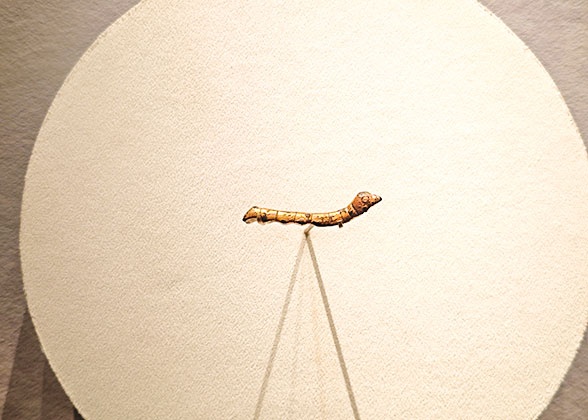 |
| The Giltbronze Silkworm in Qin Han Museum |
7. Lacquer Pig
Qin Dynasty (221 BC-207 BC)
A vivid pig lacquerware
8. Gilded Silver Bamboo-Jointed Copper Incense Burner
Han Dynasty (206 BC-220 AD)
A gilded incense burner
9. The Empress’ Jade Seal
Western Han Dynasty (202 BC-8 AD)
A jade seal inscribed with characters “Huang Hou Zhi Xi”
Permanent Exhibition Hall
Create Unity under Heaven, Civilization of Qin and Han Dynasties
The exhibition hall is divided into two floors, covering an area of 3,530 square meters (0.8 acres), with a total exhibition length of 1,194 meters (3918 feet) and a total of 732 exhibits. Through rich display design and rare cultural relics, the exhibition fully showcases the social life, cultural arts, military system, etc. of the Qin and Han dynasties. In addition, the exhibition hall operates multimedia and optical and electrical devices to vividly present these cultural relics to visitors.
1. Preface Hall
The Introduction Hall is dominated by a magnificent bronze sculpture group called “Qin Soul,” which spans 74 meters (243 feet) in length and 9.5 meters (31 feet) in height. This sculpture group features the heads of four emperors from the Qin and Han dynasties, surrounded by the distinctive buildings and major historical events of this period, vividly depicting the process of how Qin grew from a small state to a powerful empire.
2. Six Units with Different Themes
This section uses illustrations to show the hierarchy of officials in the Qin and Han dynasties and their seals; it also showcases exquisite relics such as Tiger-Shaped Tally of Du, Terracotta Warriors, bronze weapons, and maps of the Qin and Han territories to demonstrate the strength of the country at that time.
In the legal section, interactive devices allow visitors to become judges of that era through multimedia interactive experiences, enabling them to understand the differences between modern law and the law 2,200 years ago by trying cases based on the laws of that era.
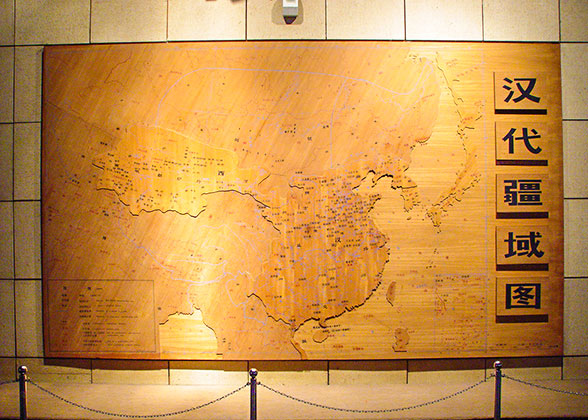 | 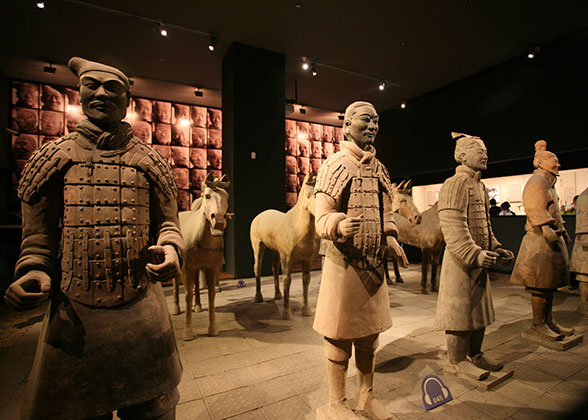 |
| The territory map of Han Dynasty in Qin Han Museum | Terracotta Warriors in Qin Han Museum |
In this area, the exhibition focuses on the economy of the Qin and Han dynasties, showcasing the currencies of various countries before the unification of Qin and the currency after the unification. Visitors can have a vivid and concrete understanding of the complex and diverse currencies circulating in the market before Qin Shi Huang unified the currency. On the other hand, dynamic paintings and brick sculptures are used to depict a vivid and lively picture of farming scenes in the Qin and Han dynasties, accompanied by real iron farming tools.
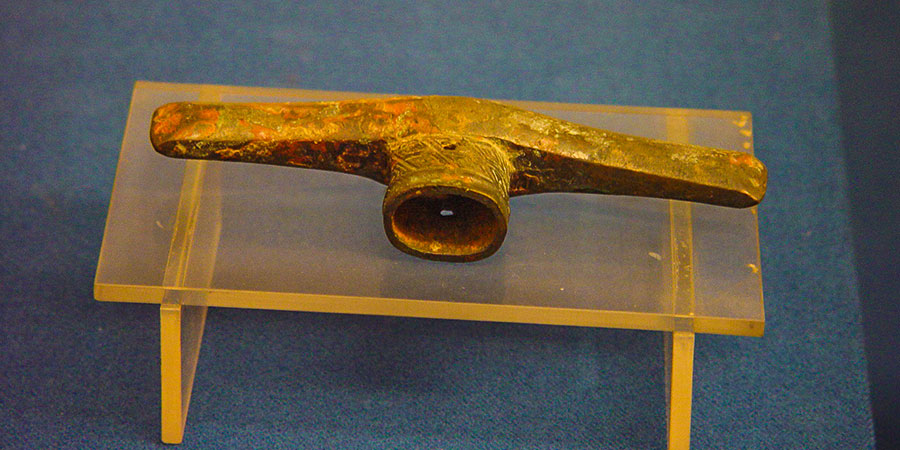 |
| An iron farming tool in Qin Han Museum |
This area shows visitors the process of the establishment of Confucianism through cultural relics and interactive areas. The “Lecture Hall” scene is set up to integrate the situational elements of the Han Dynasty classroom with the incense device. Visitors can sit down, bathing in the faint orchid fragrance and listening to the clear reading of children's education in the Han Dynasty. From such a specific interactive process, visitors can deeply perceive the importance of Confucian classics in Han Dynasty.
This area showcases the rich achievements in humanistic and artistic fields of the Qin and Han dynasties through boards, relics, and multimedia installations from various angles. The relics are introduced using the angle of “lines, colors, shapes.” Among the cultural relics in this area, a group of animal-shaped relics are very popular because of their vivid portrayal and lively and cute shapes.
From the perspective of science and technology, the relics showcase the development of national engineering, papermaking, medicine, astronomy, etc. of the Qin and Han dynasties. The existence of a relic, Wild Goose and Fish Bronze Lamp, confirms that the people had an environmental awareness more than 2,200 years ago.
In this section, the classic relics of early Qin culture and cultural exchange with Eurasia are displayed, showing that the Qin dynasty had begun to exchange with the outside world more than 2,200 years ago.
3. Tail Hall
The grand finale of the exhibition is the “The Great Stability of China,” showing good wishes for the country.
Special Exhibition Hall
1. City & Mausoleum
“City” represents the world we lived in, and “Mausoleum” represents the underground city where the deceased are located. The exhibition showcases the archaeological excavation achievements of four major sites from the Qin and Han dynasties, including Xianyang, and Chang'an - today’s Xi’an, to express the value of cultural heritage to modern society.
2. Technology and Beauty
Unlike previous exhibitions, while walking through this exhibition hall, visitors can enjoy soothing music, watch the elegant posture of music and dance, appreciate the fluid brushstrokes of calligraphy, the vivid colors of painting, and the faint fragrance of incense burners, allowing them to embark on an exciting journey through ancient Qin and Han art and technology in a multi-sensory experience of sight, hearing, smell, taste, and touch.
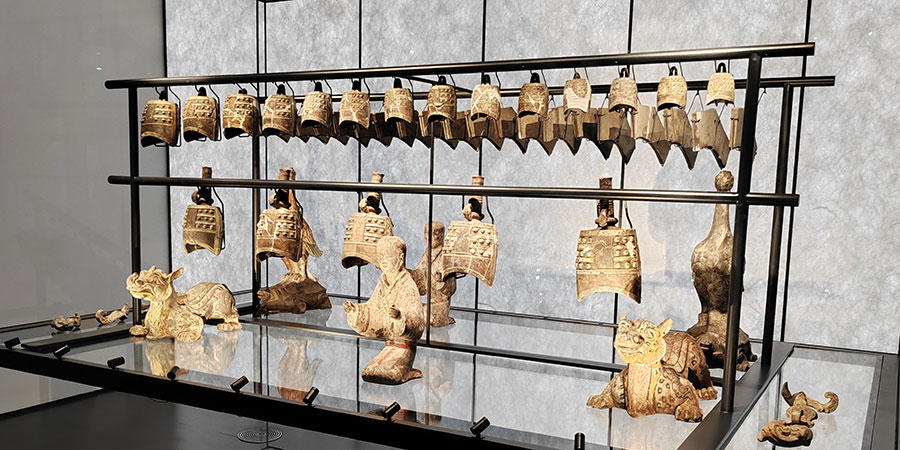 |
| Pottery figurines and musical instruments in Qin Han Museum |
Temporary Exhibition Hall - Silk Road Exhibition
This exhibition was held to celebrate the 10th anniversary of the Silk Road being inscribed on the World Heritage List. It showcases cultural relics from various countries along the Silk Road that originated from Chang'an. Don't forget to collect the stamps from different places along the Silk Road as a souvenir in this exhibition hall.
How to Get to Qin Han Museum of Shaanxi History Museum
| Entrance Fee | Free but reservation is needed. The museum issues 20,000 tickets daily. |
|---|---|
| Opening Hours | 08:30 - 19:00 (last entry at 17:30) every day |
| Recommended Time for a Visit | 2-3 hours Tip: Tourists are suggested to avoid visiting the museum in July and August because of the crowdedness. Chinese summer vacation is from July to August so that many parents bring their children to travel during this period. |
- Last updated on Mar. 31, 2025 by Gabby Li -
